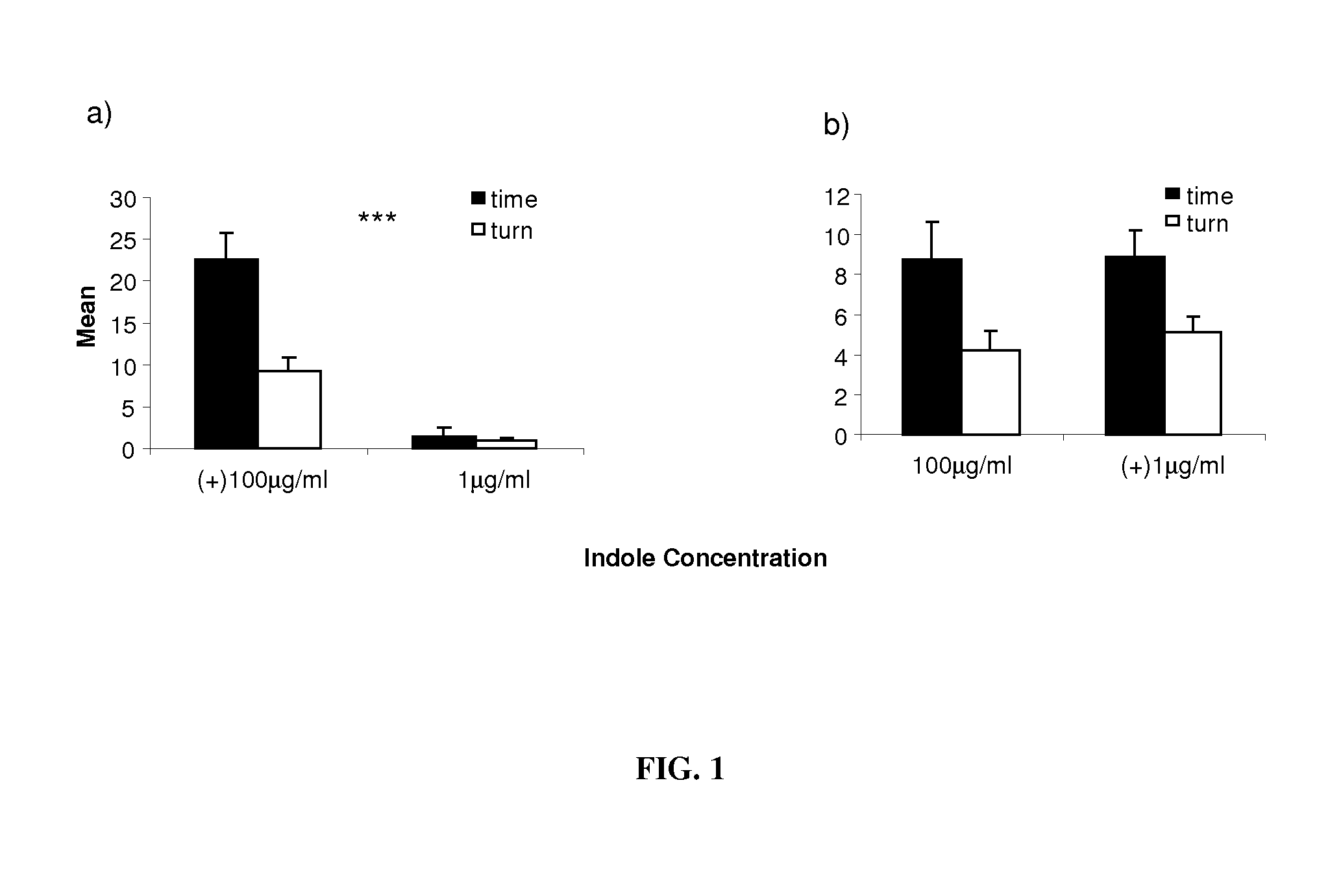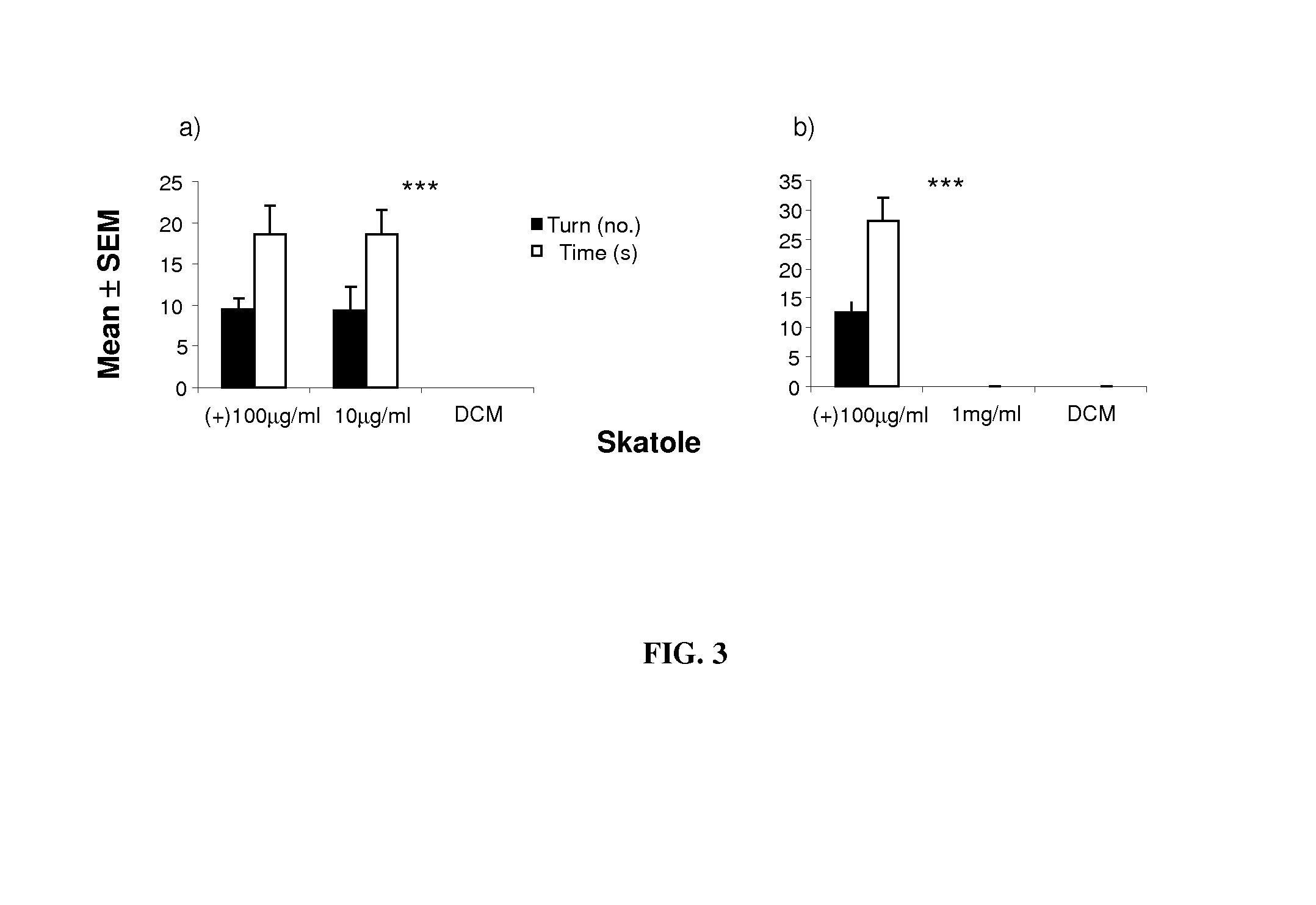Method to condition an invertebrate to detect a concentration range of a chemical compound
a technology of chemical compound and invertebrate, which is applied in the field of conditioning an invertebrate to respond to a compound, can solve problems such as u.s. pat. nos
- Summary
- Abstract
- Description
- Claims
- Application Information
AI Technical Summary
Benefits of technology
Problems solved by technology
Method used
Image
Examples
example 1
Female Wasps Conditioned to Indole at 100 μl / ml and 1 μl / ml
[0039]Female wasps were conditioned to a 30 μl solution of indole (Spectrum Chemical MFG CORP., Gardena, Calif.) dissolved in dichloromethane at either 100 μg / ml or 1 μg / ml. The solvent was allowed to evaporate for one min before the assay. The conditioning arena consisted of a 9 cm d, 1.5 cm h metal ring covered with aluminum foil that was placed inside a glass petri dish (10 cm d and 1 cm h) containing the compound-laden filter paper (2.5 cm d). A small (4 mm2) piece of filter paper laden with the sugar water (1 molar sucrose solution) was placed at the center of the metal ring covered with aluminum foil. A total of 9 holes (ca 1 mm d) were punctured around the tissue paper so that diffusing volatiles could be perceived as they fed on the sugar water. Wasps were allowed to feed for 10 s three times with 30 s between feedings. All conditioning and testing was done under a chemical fume hood. The conditioning arena was repla...
example 2
Positive Food Conditioning to Indole at 100 μg / ml and 1 μg / ml while Negative Conditioning to Indole at 100 μg / ml
[0041]The arena and procedure for testing were as described in Example 1. However, the wasps were conditioned via positive food conditioning of sugar-water to indole at 1 μg / ml. Additionally, the same wasp was also negatively food conditioned to 100 μg / ml of indole with water. Each female was test with a single indole concentration at either 100 μg / ml of indole or at 1 μg / ml. A total of 20 females (10 to high and 10 to low concentrations) were tested per day over 2 days. As depicted in FIG. 2, the wasps responded to the conditioned concentration but did not respond to the negatively conditioned concentration. This is in contrast to FIG. 1B where wasps lacking in a negative conditioning to 1 μg / ml did not distinguish that concentration of indole.
example 3
Conditioning to Individual Concentrations of Skatole
[0042]The arena and procedure for testing were as described in Example 1. However, the wasps were conditioned via positive food conditioning of sugar-water to 30 μl of conditioning solution of skatole dissolved in dichloromethane at either 0.001 μg / ml, 0.01 μg / ml, 0.1 μg / ml, 1 μg / ml, 10 μg / ml, or 100 μg / ml. A 1 molar sucrose solution was used as the unconditioned stimulus (reward).
Conditioned to 100 μg / ml of Skatole
[0043]Wasps conditioned to 100 μg / ml skatole and tested to detected skatole at 100 μg / ml, 10 μg / ml and DCM (control) responded to both skatole concentrations (FIG. 3A), but when tested to skatole at 100 μg / ml, 1 mg / ml and DCL, they only responded to the conditioning concentration (FIG. 3B).
Conditioned to 10 μg / ml of Skatole
[0044]Wasps conditioned to 10 μg / ml skatole and tested to skatole at 10 μg / ml, 1 μg / ml and DCM (control) responded to both skatole concentrations (FIG. 4A), but when tested to skatole at 10 μg / ml, 100 ...
PUM
 Login to View More
Login to View More Abstract
Description
Claims
Application Information
 Login to View More
Login to View More - R&D
- Intellectual Property
- Life Sciences
- Materials
- Tech Scout
- Unparalleled Data Quality
- Higher Quality Content
- 60% Fewer Hallucinations
Browse by: Latest US Patents, China's latest patents, Technical Efficacy Thesaurus, Application Domain, Technology Topic, Popular Technical Reports.
© 2025 PatSnap. All rights reserved.Legal|Privacy policy|Modern Slavery Act Transparency Statement|Sitemap|About US| Contact US: help@patsnap.com



